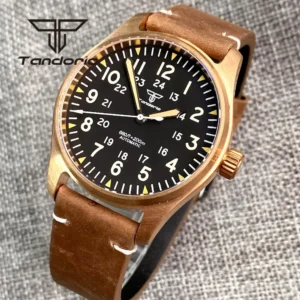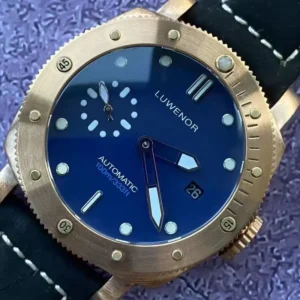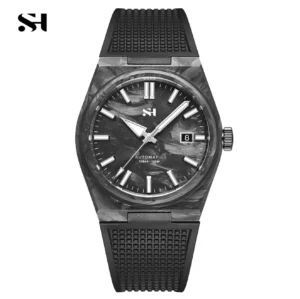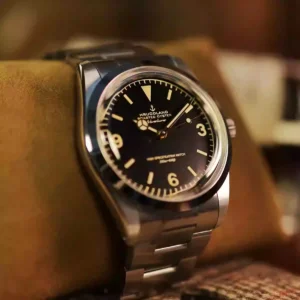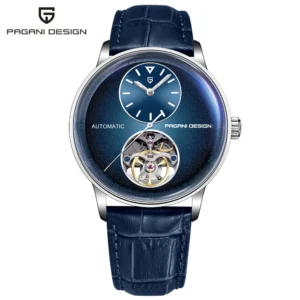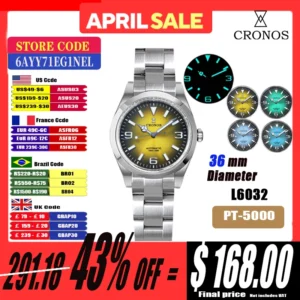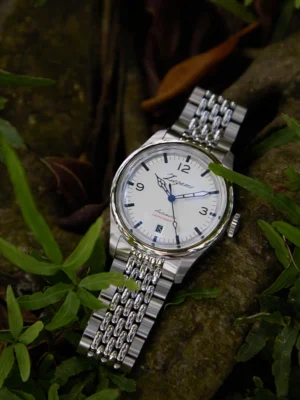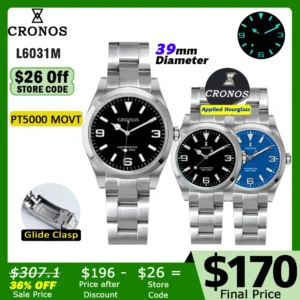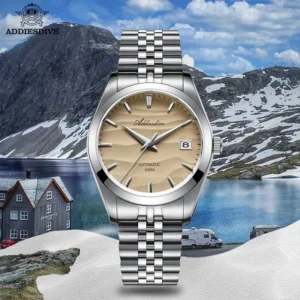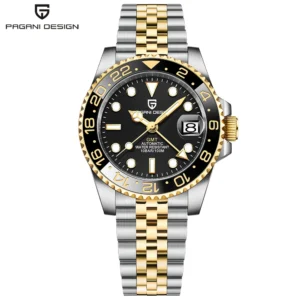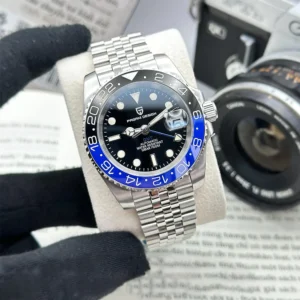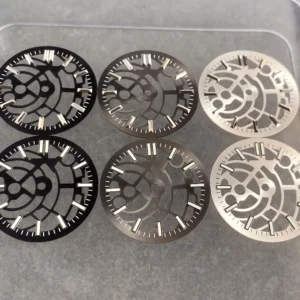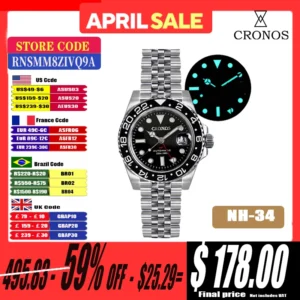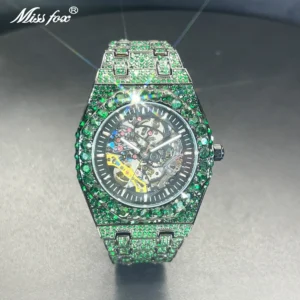Classic Style Dive Watches
Discover heritage-inspired dive watches blending timeless style with true dive function. Perfect for adventures or daily wear, these pieces offer reliability and enduring appeal.
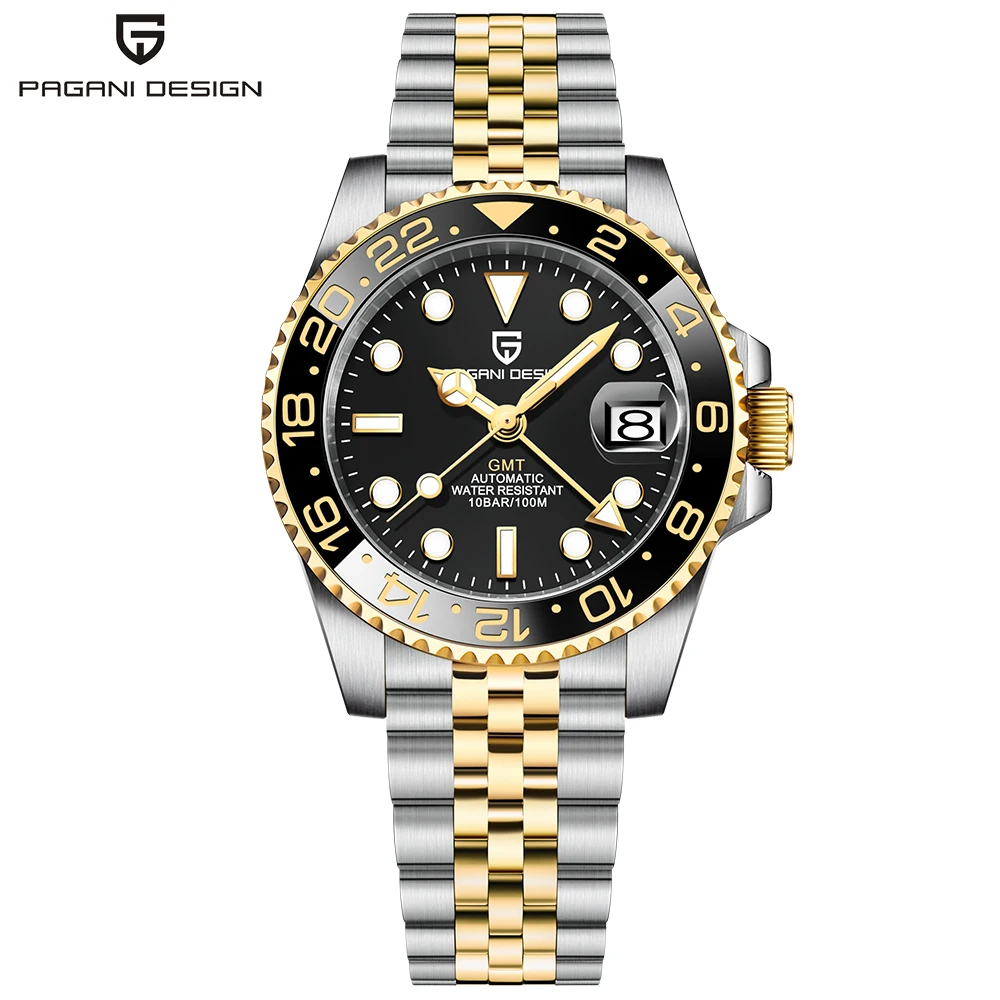
Showing 1–12 of 90 results
Bronze Automatic Watches, Classic Style Dive Watches, Professional Spec Dive Watches
Price range: $388.50 through $484.33 Select options This product has multiple variants. The options may be chosen on the product pageBronze Automatic Watches, Classic Style Dive Watches, Day Date Automatic Watches
Price range: $464.05 through $479.74 Select options This product has multiple variants. The options may be chosen on the product pageClassic Style Dive Watches, Professional Spec Dive Watches
$1,031.49 Select options This product has multiple variants. The options may be chosen on the product pageClassic Automatic Dress Watches, Classic Style Dive Watches, Day Date Automatic Watches
$1,575.87 Select options This product has multiple variants. The options may be chosen on the product pageClassic Automatic Dress Watches, Classic Style Dive Watches, Day Date Automatic Watches
$432.86 Select options This product has multiple variants. The options may be chosen on the product pageClassic Style Dive Watches, Square & Rectangular Automatic Watches
Price range: $748.48 through $1,106.46 Select options This product has multiple variants. The options may be chosen on the product pageClassic Automatic Dress Watches, Classic Style Dive Watches, Thin Automatic Dress Watches
Price range: $673.20 through $1,081.20 Select options This product has multiple variants. The options may be chosen on the product pageAutomatic Chronograph Watches, Classic Automatic Dress Watches, Classic Style Dive Watches
$617.17 Select options This product has multiple variants. The options may be chosen on the product pageClassic Automatic Dress Watches, Classic Style Dive Watches, Professional Spec Dive Watches
Price range: $767.55 through $1,182.89 Select options This product has multiple variants. The options may be chosen on the product pageClassic Field Watches, Classic Style Dive Watches, Professional Spec Dive Watches
Price range: $486.57 through $489.16 Select options This product has multiple variants. The options may be chosen on the product pageClassic Style Dive Watches, GMT Automatic Watches, GMT Dive Watches
Price range: $440.04 through $440.12 Select options This product has multiple variants. The options may be chosen on the product pageClassic Style Dive Watches, GMT Automatic Watches, GMT Dive Watches
Price range: $409.04 through $450.14 Select options This product has multiple variants. The options may be chosen on the product page
Showing 1–12 of 90 results
Timeless Elegance Beneath the Waves: Classic Style Dive Watches
What Defines a Classic Style Dive Watch?
Classic style dive watches represent the perfect marriage of form and function in the world of horology. These timepieces embody a timeless aesthetic that has remained largely unchanged for decades, featuring clean, legible dials, robust cases, and functional rotating bezels. Unlike their ultra-technical modern counterparts, classic dive watches embrace simplicity and restraint while maintaining their underwater capabilities.
What truly defines these watches is their harmonious balance of utilitarian purpose and refined elegance. The visual language speaks through thoughtful restraint—contrasting indices against dark dials, purposeful hands designed for at-a-glance reading, and proportions that feel as appropriate today as they did half a century ago.
The hallmarks are unmistakable: unidirectional rotating bezels for tracking elapsed time, luminous markers for underwater visibility, and substantial crowns often protected by crown guards. These design elements weren’t created arbitrarily but evolved through actual underwater use and necessity.
Perhaps most remarkably, classic dive watches possess a chameleon-like versatility rarely found in purpose-built tools. These timepieces transition seamlessly from ocean depths to boardroom meetings, pairing as naturally with wetsuits as with business suits—a testament to their enduring appeal and thoughtful design.
The Heritage and Evolution of Classic Dive Timepieces
The lineage of today’s classic dive watches traces back to pioneering water-resistant timepieces from the 1920s and 1930s. These early innovations laid the groundwork with hermetically sealed cases and cork or rubber gaskets to protect against moisture—though they were hardly suitable for true diving conditions.
The 1950s and 1960s marked the golden age of dive watch development, coinciding with the post-war boom in recreational diving. As underwater exploration captured the public imagination, watchmakers responded by creating purpose-built timepieces combining water resistance with practical features for divers.
Revolutionary innovations emerged during this period: the unidirectional rotating bezel (preventing accidental extension of dive times), improved gasket systems enabling greater depths, and the application of luminous material to hands and indices for underwater legibility. Water resistance standards improved dramatically, with 100-meter ratings becoming commonplace.
Over subsequent decades, these watches evolved from pure tools to cultural icons, their designs transcending utilitarian origins while maintaining core functionality. Modern professional-spec dive watches may offer extreme depth ratings and advanced materials, but they all carry the DNA established during this formative era.
What’s most remarkable is how little the fundamental design language has changed. While manufacturing techniques and materials have improved, the classic dive watch remains instantly recognizable—a testament to the enduring rightness of its original conception.
Essential Design Elements of Timeless Dive Watches
Classic dive watches share distinctive design elements that define the category:
Case Design: Traditional proportions typically range from 36mm to 40mm in diameter—substantial enough for legibility underwater yet comfortable for daily wear. Cases favor robust materials like stainless steel with a focus on durability rather than lightness. Many feature distinctive profiles with prominent lugs and crown guards.
Bezel Function: The hallmark unidirectional rotating bezel represents both form and function in perfect harmony. This safety feature prevents accidental rotation that might underestimate elapsed dive time. Traditional aluminum or bakelite inserts display clear timing markers, with the first fifteen minutes often featuring minute-by-minute graduations for critical decompression timing.
Dial & Hands: Legibility remains paramount with high-contrast color schemes—typically black dials with white markers. Distinctive hand shapes prioritize instant differentiation between hour and minute indicators, crucial when checking time at a glance. Luminous applications on hands and indices ensure visibility in dark underwater environments.
Crystal & Crown: Domed crystals—historically acrylic but now often sapphire—provide distortion-free reading at angles. Screw-down crowns create water-tight seals when properly secured, a critical feature for maintaining water resistance during submersion.
Technical Requirements: True dive watches offer a minimum water resistance of 100 meters (330 feet), though many classic models provide 200 meters (660 feet) or more. Movements emphasize reliability over complexity, prioritizing consistent performance under varying conditions.
Archetypal Models That Defined the Category
Certain design languages have become immediately recognizable in the dive watch world, establishing standards that continue to influence contemporary timepieces. These archetypal families emerged primarily during the 1950s and 1960s when pioneering designs established distinctive visual identities through thoughtful combinations of case shapes, bezel designs, and dial configurations.
Some designs featured distinctive sword hands and rectangular indices that would become instantly recognizable signatures. Others pioneered the “big crown” aesthetic, eliminating crown guards for easier operation with diving gloves. Still others popularized the cushion case shape that became emblematic of 1970s dive watch design.
What unites these diverse approaches is their enduring influence. Modern interpretations continue to reference these archetypal designs, sometimes updating them with contemporary materials like ceramic bezels or enhanced movements while preserving their essential character.
These foundational designs have transcended their utilitarian origins to become cultural icons, appearing on the wrists of film characters, explorers, and style icons—solidifying their status in horological history.
The Timeless Appeal: Why Classic Dive Watches Endure
Classic dive watches maintain their allure decade after decade for compelling reasons. Their versatility stands unmatched—equally appropriate with casual weekend attire or business suits. The robust construction that makes them suitable for underwater use also ensures they withstand the rigors of daily wear, often becoming treasured heirlooms passed through generations.
Unlike trend-driven timepieces, classic dive watches follow a design language that has proven timeless. Their proportions, color schemes, and overall aesthetic remain as relevant today as when first conceived. This longevity offers reassurance that today’s investment won’t appear dated in coming years.
Beyond practical considerations lies an emotional connection. These watches evoke the spirit of adventure and exploration, linking wearers to undersea pioneers and suggesting capabilities beyond everyday life. Even for those who never venture beneath the waves, there’s satisfaction in wearing a precision instrument designed to perform under extreme conditions.
For many enthusiasts, classic dive watches also represent appreciation for mechanical craftsmanship. In an age of disposable technology, these mechanical timepieces celebrate traditional watchmaking virtues—precision engineering made to last decades rather than months.
Finding Your Perfect Classic Dive Watch: Key Considerations
When selecting your ideal classic dive watch, several factors warrant careful consideration:
Authenticity Considerations: Decide whether you prefer vintage authenticity or modern reliability with heritage-inspired design. Original vintage pieces offer historical significance but may require specialized maintenance, while contemporary interpretations provide similar aesthetics with modern manufacturing standards.
Technical Factors: Match water resistance to your intended activities—100m (330ft) suffices for swimming and snorkeling, while serious diving demands 200m (660ft) or greater. Consider crystal materials carefully; sapphire offers superior scratch resistance, while acrylic provides vintage charm and is less prone to shattering.
Wearability Aspects: Be honest about what feels comfortable on your wrist. Classic dive watches typically range from 36mm to 42mm, with larger sizes becoming common in recent decades. Consider bracelet versus strap options—stainless steel bracelets offer durability and security, while rubber provides flexibility for actual diving.
Budget Categories: Quality options exist across varied price points. Entry-level automatic watches deliver classic aesthetics with reliable movements, mid-range offerings often feature improved materials and movements, while premium examples showcase refined finishing and exclusive calibers.
Preserving the Legacy: Care for Your Classic Diver
Proper maintenance ensures your classic dive watch provides decades of reliable service. For mechanical skeleton watches and other automatic timepieces, establish a regular service schedule—typically every 5-7 years—with qualified watchmakers who can clean, lubricate, and verify water resistance.
Before aquatic activities, always ensure the crown is properly secured in its screw-down position. After exposure to saltwater, rinse thoroughly with fresh water to prevent corrosion, paying particular attention to the bezel area where salt can accumulate.
For daily cleaning, a soft cloth will remove fingerprints and oils from the case and crystal. Avoid chemical cleaners that might damage gaskets or finishes. When storing unworn watches, maintain them in a cool, dry environment away from direct sunlight which can fade dial colors over time.
For bracelet maintenance, occasional cleaning with mild soap and a soft brush will remove accumulated dirt from between links. Leather straps should be kept dry and occasionally treated with appropriate leather conditioners to prevent cracking.
FAQ: Common Questions About Classic Style Dive Timepieces
Can classic style dive watches be used for actual diving?
Modern classic-styled dive watches with appropriate water resistance (200m/660ft minimum) and intact seals are generally suitable for recreational diving. However, professional divers typically supplement with dedicated digital dive computers for critical measurements.
How does vintage styling affect functionality in modern interpretations?
Contemporary automatic dive watches with vintage aesthetics typically combine classic design elements with modern technical improvements like enhanced water resistance, sapphire crystals, and more precise movements—offering the best of both worlds.
What defines “authentic” heritage-inspired design?
Authenticity in heritage designs typically means faithfulness to original proportions, dial layouts, hand shapes, and overall aesthetic. The most respected interpretations balance historical accuracy with subtle modern improvements that don’t compromise the original design ethos.
Are mechanical movements necessary in a classic dive watch?
While not strictly necessary, mechanical movements remain preferred by enthusiasts for their historical accuracy, craftsmanship, and independence from batteries. High-quality automatic movements offer reliability comparable to quartz while maintaining traditional horological values.
Choosing Between Vintage and Heritage-Inspired Designs
The decision between authentic vintage pieces and modern heritage-inspired designs involves several tradeoffs. Vintage watches offer genuine historical connection and often develop unique character through patina—the natural aging of dial, hands, and bezel. However, they typically offer limited water resistance by today’s standards, may contain hazardous luminous materials, and present challenges in finding qualified service providers.
Modern heritage-inspired pieces from Sharp Aspect and other quality manufacturers offer improved reliability, readily available parts, contemporary water resistance standards, and often come with warranties. Their advanced manufacturing ensures consistent quality, while non-radioactive luminous compounds provide superior nighttime visibility compared to aged vintage luminous elements.
For many enthusiasts, modern GMT dive watches and other heritage-inspired designs represent the ideal compromise—capturing vintage aesthetic appeal while delivering contemporary performance and peace of mind.
Complementing Your Collection: Versatility of Classic Dive Watches
A well-chosen classic dive watch often becomes the cornerstone of a diverse timepiece collection. Their versatility allows them to complement any watch wardrobe—from formal dress pieces to rugged field watches. Many enthusiasts discover that their dive watch receives disproportionate wrist time precisely because it transitions so effortlessly between settings.
This adaptability extends to customization through different straps. The same watch transforms from sporty to sophisticated simply by switching from rubber to leather, or from casual to refined by changing from NATO fabric to stainless steel bracelet.
Beyond practicality, classic dive watches connect wearers to a rich horological tradition celebrating human ingenuity and adventure—making them not just timekeeping instruments but meaningful expressions of personal style and appreciation for precision engineering that stands the test of time.

